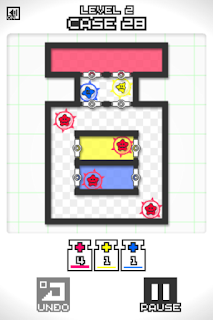I suggest turning off the music. Otherwise it might get stuck in your head for all day :-)
The basic idea is this: you see the map of a lab. Some rooms contain viruses, other rooms contain antidote gas. When gas comes in contact with a virus of the same color, both disappear. The goal is to remove all viruses.
To play the game, you control doors. The basic type of door can only be opened. When you open a door, gas spreads as far as it can go and cannot be stopped.
The most useful doors can be both opened and closed. This is important because, since when you kill a virus the gas you used disappears as well, you often need to seal some gas into a closed room to reuse it later. The room at the top of this level has that kind of door.
Another important limitation is that you cannot open a door if it separates two rooms containing gas of different colors. So in the example above, after opening the door on the left you wouldn't be able to open the door on the top right.
In a tradition common to other Japanese puzzles, many levels are shaped like animals, fruit, or other objects. This one is a jar. Also note that a few of the viruses have a shield surrounding them. This means that you have to hit them twice to kill them.
In some puzzles, there are also doors protected by a force field, which cannot be used until all viruses of that color have been killed.
Finally, a puzzle game involving colors wouldn't be complete without a way to mix them. This is done using fans. Here you need to mix blue and yellow to get green.
Fans can also be used simply to move gas from one room to another, as if you opened a door and immediately closed it again (which isn't possible with normal doors).
Solving these puzzles is enjoyable and requires finding the correct order that viruses need to be taken down while also allowing you to save some gas to kill the remaining ones. The solution often isn't unique, but in the hardest puzzles there is less freedom of choice.
There's a total of 100 puzzles, split across 5 difficulty levels. You start with 20 unlocked, and then every 10 puzzles solved, a new group of 10 is unlocked.
The puzzles vary in shape and size. The largest ones require precise touches on the iPhone's small screen, however if you make a mistake you can always use the undo button.
The price is currently $2.99, which I think is justified by the originality of the mechanics, however it dropped as low as $0.99 a few times since when the game was released in 2011.
If you want to try a free version first, there are actually two:
Vaccine Case LITE - 12 levels that show most of the mechanics of the full version.
Vacchine Case [headache] - 12 new, exceptionally hard levels. I solved only 1 of them!
Summary
| Nontrivialness | ★★★★★ |
| Logical Reasoning | ★★★★★ |
| User Interface | ★★★☆☆ |
| Presentation | ★★★☆☆ |
| Loading Time | ★★★★★ |
| Saves Partial Progress | ✘ |
| Status Bar | ✘ |
©2013 Nicola Salmoria. Unauthorized use and/or duplication without express and written permission is strictly prohibited. Excerpts and links may be used, provided that full and clear credit is given to Nicola Salmoria and nontrivialgames.blogspot.com with appropriate and specific direction to the original content.







